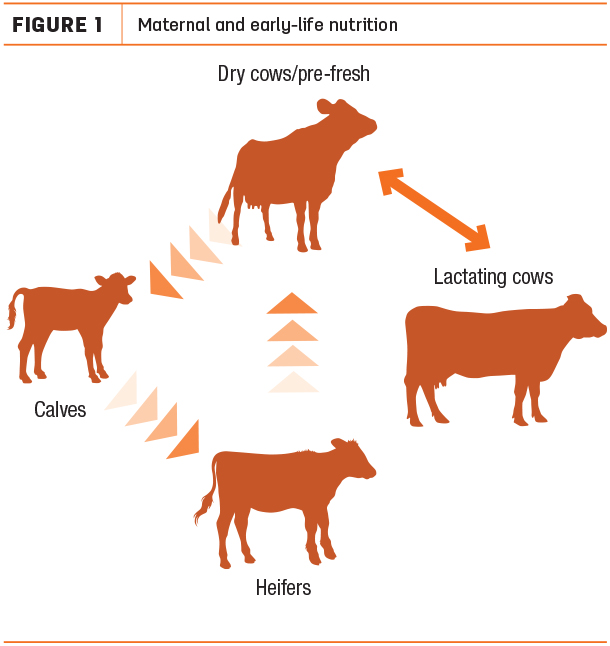As a dairy producer, ensuring your calves have the best start to life begins before the calf is born. The care and nutrition you provide the cow while its calf is in utero can set that calf up for life.
While the effects of nutrition during lactation can be quantified immediately, the effects maternal and early life nutrition have on the future dairy cow can reach far into adulthood. Apart from the obvious monetary and labor costs required to treat sick calves, there are potential production losses related to illness that occurs during the calf’s first eight weeks of life that can crop up much later.
Health and immune status during the pre-weaning period are critical determinants of performance during weaning, breeding and lactation. Maternal and early life nutrition drive calf health and must be incorporated into a lifetime approach to producing high-yielding dairy cattle.
Ensuring the productive cow of tomorrow will depend on feeding and managing the cow of today, while nourishing the pregnant cow will allow for the full expression of its calf’s genetic potential.
Programmed nutrition early in life is key for long-term health
Metabolic programming during fetal development and early life can impact growth rate and mammary development, which is an obvious link to future milk production. Both in utero and post-calving, the calf experiences a certain elasticity in the development of its metabolic and digestive systems.

This allows producers to program nutrition in a way that positively influences gene expression, impacting the calf’s growth, reproduction and production as a mature cow. These changes in DNA structure are heritable and will be passed on to future generations, meaning the future of the herd starts before the calf is even born.
The concept of maternal nutrition impacting an offspring’s performance as an adult was first proposed by Dr. David Barker from the University of Southampton and others. It was based on epidemiological studies of pregnant women who experienced low nutrient intake during the Dutch famine of World War II.
Barker found the offspring of women who were undernourished during pregnancy were more likely to display a “thrifty” phenotype and more efficient uptake of nutrients. These data indicated the poor nutrition of the mother caused the fetus to adapt to low nutrient availability in utero via altered gene expression, resulting in an adult who was better adapted to poor nutrition.
The same principle applies to calves in utero. Maternal nutrition can directly impact offspring during fetal development of organ systems, such as the liver, pancreas, mammary gland and reproductive glands, as well as muscle, fat and bone deposition. The energy and protein balance of the dam have been shown to impact late-gestation fetal development.
Insufficient energy supply to the dam during gestation has been shown to reduce both fetal and pre-weaning growth of the calf, with these effects persisting into later life depending on postnatal nutrition. These effects can include reduced growth and milk production as well as delayed onset of puberty in offspring whose dams were underfed. On the opposite end of the spectrum, excess energy supply to the dam can lead to underweight calves due to poor glucose metabolism and poor colostrum nutrition.
Right time, right nutrition: Feeding during the dry period to optimize calf health
On the dairy farm, the dry period is used to recondition the cow to ready it for calving and lactation, and also to target nutrition for the growing fetus. Seventy-five percent of fetal growth occurs during the last three months of gestation, so the nutrition of the cow during the dry period has the potential to greatly influence the calf’s growth and performance.
In addition, nutrition during the dry period can influence colostrum composition, impacting the transfer of passive immunity to the calf and strengthening its health early in life.
While both energy and protein supply have been studied in relation to maternal nutrition and offspring performance, micronutrients such as trace minerals and vitamins have not received much investigation. Trace mineral sources have emerged as significant contributors to animal performance, immunity and fertility.
Recently, a long-term study examined the impact of trace mineral sources (sulfates versus proteinates) when fed to late-gestation cows on their offspring. Researchers found heifers from cows that received organic minerals during the dry period were healthier during the pre-weaning period (zero to 8 weeks old), as indicated by improved overall health scores and reduced biomarkers for disease.
Calf health and growth during the first eight weeks of life have been shown to impact milk production through the first lactation. Calves that never or rarely experience sick days produce more milk in the first lactation than calves that are sick more often.
Heifers from cows that received proteinate trace minerals during the dry period attained puberty faster and calved about one month earlier than heifers from cows receiving sulfate trace minerals during the dry period. The impacts of trace mineral source on fertility and reproduction may be attributed to improved bioavailability and the intestinal absorption of proteinate trace minerals compared to sulfates.
These data indicate trace mineral sources during late gestation can impact a calf’s early life health and the fertility of the mature cow. Through immune function support and fewer sick days in young calves, proteinate trace minerals have been shown to optimize reproductive and lactation performance of springing heifers.
Don’t wait until after the calf is born to focus on health and performance. Nutritional support of the pregnant cow can lead to healthy calves now and in the future, resulting in a healthy and productive herd and a profitable farm. ![]()
References omitted but are available upon request. Click here to email an editor.

-
Amanda Gehman
- Research Project Manager
- Alltech
- Email Amanda Gehman






